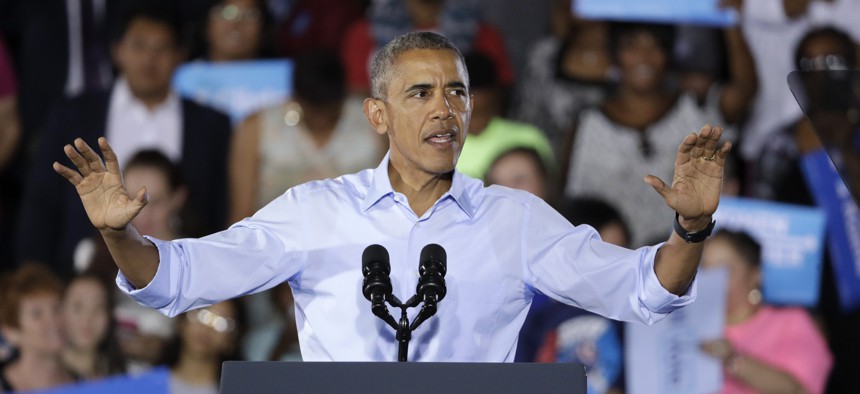
President Barack Obama speaks at a rally Sunday, Oct. 23, 2016, in North Las Vegas, Nev. John Locher/AP
Obama to Successor: Put Fed IT Under One Roof, For Its Own Protection
Obama officials say they're preparing an 'options paper' for the next president’s transition team that envisions consolidating IT services similar to the way DISA works within the Defense Department.
Obama administration cyber officials plan to urge the next president’s team to drastically centralize information technology services to reduce the risk of another massive data breach, a White House official said today.
Those officials are preparing an “options paper” for the next president’s transition team that envisions consolidating IT services for small agencies, among other recommendations, Trevor Rudolph, chief of the Office of Management and Budget’s cyber and national security unit, told an advisory panel.
Consolidating small agencies’ digital systems could lead to greater consolidation in the future, he said.
The recommendation is a follow on to the president’s Cybersecurity National Action Plan, issued in the wake of a massive data breach at the Office of Personnel Management that compromised records of 21.5 million current and former federal employees.
“My message to the next administration is we really need to go down this path of centralization, to actually reduce the risk surface as opposed to increase it,” Rudolph told members of the National Institute of Standards and Technology’s Information Security and Privacy Advisory Board.
Rudolph’s office is also working on more detailed guidance for how agencies should designate and protect “high-value assets” hackers might want to steal or snoop on, as another follow on to the national action plan, he said. OMB will issue that guidance in the next few weeks, he said.
OMB issued guidance for agencies today on modernizing IT portfolios to ward off cyberattacks and breaches.
The centralized IT service envisioned by the White House might function similarly to the way the Defense Information Systems Agency provides centralized IT services to the Defense Department, Rudolph said, though he stressed that was merely an analogy, not a model.
Rudolph declined to specify a timeline for the consolidation, saying that should be decided by the next administration. He did say he expected it could be accomplished during the next president’s term of office.
Government technologists have proposed a bevy of IT modernization, consolidation and shared service plans, many of them with limited success. The urgency of centralizing IT has grown significantly in the wake of the OPM breach, however, Rudolph said.
“In a post-OPM world, we realized all agencies perhaps shouldn’t be making these [IT] decisions,” he said.
Two major hurdles to successful consolidation, he said, will be allocating enough money in the fiscal 2018 budget and rejiggering IT and security authorities so the Homeland Security Department can actively secure the consolidated systems.
All the consolidation recommendations would build on existing shared IT services programs and governmentwide security systems such as DHS’ Einstein and Continuous Diagnostics and Mitigation programs, Rudolph said.
Making those programs most effective may require revising the Federal Information Security Management Act to give DHS broader authority to deploy those and future security systems, he said.




